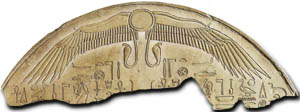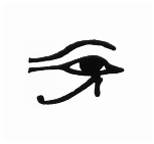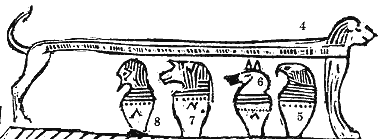A FACSIMILE FROM THE BOOK OF ABRAHAM
 No. 1
No. 1
|
In Ur of Chaldees, Abraham was to be offered in sacrifice. The corruption
in religion had taken the concept of 'God's Sacrifice' and turned
it into human sacrifice. Later when Abraham had sojourned down into
Egypt, he records the event using Egyptian motifes like facimile number
1. The Egyptians had preserved much of the covenant ceremonies of the gospel
but without the proper priesthood authority. Just as Joseph Smith's
purposeful envolvement in Masonary for informative purposes to see
preserved ceremonies performed without proper authority,
so it was with Abraham in Egypt. Abraham would learn what was preserved in
Egypt of the ordinances of salvation. As this was central to Abraham's
purpose in the Lord in Egypt, it should not be surprising that the copied
papyra record of Abraham, which Joseph Smith translated, contained the 'Book
of the Dead' and other such Ceremonial Ordinances of the Egyptians.
|
|
Scriptural Text [& Editorial]
|
Commentary & Explanation
|
Footnotes ~ References ~ JST
|
 EXPLANATION
EXPLANATION
|
CARICATURE
|
COMMENTARY
|
|
Fig. 1. The Angel of the
Lorda.
[When scripture speaks of the 'Angel of the
Lord' there are at least two possibilities.
It may actually be the Lord himself, or one
who has been empowered by the Lord to stand
and act in his stead. In this case with
Abraham it seems that the Lord God Jehovah
did stand as himself. When the Arch-Angel
Gabriel came to Zacharias and to Mary as
the Angel of the Lord, it was actually
Noah in his identity of Gabriel who was
standing acting in behalf of the Lord as
an Angel from the very presence of our
Lord God. As God states in D&C 1:38
" . . . whether by mine own voice or by the
voice of my servants, it is the same."]
|


|
Angel of the Lord This symbol of a
bird it the Egpytian representation the God Horus. On the one hand Horus
can be a general catchall for multiple deities. On the other the most famous
was 'Harseisis' or Horus-son-of-Isis, son of Osiris, or Son of God. Thus
he becomes a vary fitting image applied to the Angel of the Lord, who is
the Son of God. The great variety of who 'Horus' is or is not and how this
symbol is applied so variously is a testimony as to the use of a single
symbol to represent a vast stream of meaning which might be applied variously
to any particular story in any such appropiate manner as the symbol may
 variously so represent. The 'Widget Eye' of 'all seeing eye' of Horus is
particularly applicable to the all seeing eye of God. Also, in that the
Egyptian religion is but a corruption taken from the true religion, it may
well be that the more contemporary meaning of Horus in Abraham's day did
indeed more specifically correlate with the concepts of Jehovah and Jesus
Christ, and the Angel of the Lord of the Old Testament. Further the 'double
winged' symbol for Horus was associated with Horus as the son and 'heir' of
Rah or Re.
variously so represent. The 'Widget Eye' of 'all seeing eye' of Horus is
particularly applicable to the all seeing eye of God. Also, in that the
Egyptian religion is but a corruption taken from the true religion, it may
well be that the more contemporary meaning of Horus in Abraham's day did
indeed more specifically correlate with the concepts of Jehovah and Jesus
Christ, and the Angel of the Lord of the Old Testament. Further the 'double
winged' symbol for Horus was associated with Horus as the son and 'heir' of
Rah or Re.
|
|
Fig. 2. Abraham fastened upon an altar.
|

|
|
|
Fig. 3. The idolatrous priest of Elkenah attempting to offer up Abraham as a sacrifice.
|

|
|
|
Fig. 4. The altar for sacrifice by the idolatrous priests, standing before the gods of Elkenah, Libnah, Mahmackrah, Korash, and Pharaoh.
|

|
|
|
Fig. 5. The idolatrous god of Elkenah.
|

|
|
|
Fig. 6. The idolatrous god of Libnah.
|

|
|
|
Fig. 7. The idolatrous god of Mahmackrah.
|

|
|
|
Fig. 8. The idolatrous god of Korash.
|

|
|
|
Fig. 9. The idolatrous god of Pharaoh.
|

|
|
|
Fig. 10. Abraham in Egypt.
|

|
|
|
Fig. 11. Designed to represent the pillars of heaven, as understood by
the Egyptians.
|

|
|
|
Fig. 12. Raukeeyang, signifying expanse, or the firmament over our heads;
but in this case, in relation to this subject, the Egyptians meant it to
signify Shaumau, to be high, or the heavens, answering to the Hebrew word,
Shaumahyeem.
|

|
|